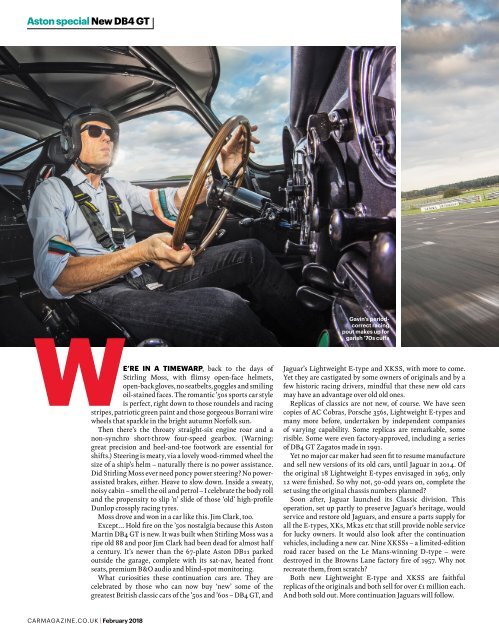You also want an ePaper? Increase the reach of your titles
YUMPU automatically turns print PDFs into web optimized ePapers that Google loves.
<strong>Aston</strong> special New DB4 GT<br />
WE’RE IN A TIMEWARP, back to the days of<br />
Stirling Moss, with flimsy open-face helmets,<br />
open-back gloves, no seatbelts, goggles and smiling<br />
oil-stained faces. The romantic ’50s sports car style<br />
is perfect, right down to those roundels and racing<br />
stripes, patriotic green paint and those gorgeous Borrani wire<br />
wheels that sparkle in the bright autumn Norfolk sun.<br />
Then there’s the throaty straight-six engine roar and a<br />
non-synchro short-throw four-speed gearbox. (Warning:<br />
great precision and heel-and-toe footwork are essential for<br />
shifts.) Steering is meaty, via a lovely wood-rimmed wheel the<br />
size of a ship’s helm – naturally there is no power assistance.<br />
Did Stirling Moss ever need poncy power steering? No powerassisted<br />
brakes, either. Heave to slow down. Inside a sweaty,<br />
noisy cabin – smell the oil and petrol – I celebrate the body roll<br />
and the propensity to slip ’n’ slide of those ‘old’ high-profile<br />
Dunlop crossply racing tyres.<br />
Moss drove and won in a car like this. Jim Clark, too.<br />
Except… Hold fire on the ’50s nostalgia because this <strong>Aston</strong><br />
Martin DB4 GT is new. It was built when Stirling Moss was a<br />
ripe old 88 and poor Jim Clark had been dead for almost half<br />
a century. It’s newer than the 67-plate <strong>Aston</strong> DB11 parked<br />
outside the garage, complete with its sat-nav, heated front<br />
seats, premium B&O audio and blind-spot monitoring.<br />
What curiosities these continuation cars are. They are<br />
celebrated by those who can now buy ‘new’ some of the<br />
greatest British classic cars of the ’50s and ’60s – DB4 GT, and<br />
Gavin's periodcorrect<br />
racing<br />
pout makes up for<br />
garish ’70s cuffs<br />
Jaguar’s Lightweight E-type and XKSS, with more to come.<br />
Yet they are castigated by some owners of originals and by a<br />
few historic racing drivers, mindful that these new old cars<br />
may have an advantage over old old ones.<br />
Replicas of classics are not new, of course. We have seen<br />
copies of AC Cobras, Porsche 356s, Lightweight E-types and<br />
many more before, undertaken by independent companies<br />
of varying capability. Some replicas are remarkable, some<br />
risible. Some were even factory-approved, including a series<br />
of DB4 GT Zagatos made in 1991.<br />
Yet no major car maker had seen fit to resume manufacture<br />
and sell new versions of its old cars, until Jaguar in 2014. Of<br />
the original 18 Lightweight E-types envisaged in 1963, only<br />
12 were finished. So why not, 50-odd years on, complete the<br />
set using the original chassis numbers planned?<br />
Soon after, Jaguar launched its Classic division. This<br />
operation, set up partly to preserve Jaguar’s heritage, would<br />
service and restore old Jaguars, and ensure a parts supply for<br />
all the E-types, XKs, Mk2s etc that still provide noble service<br />
for lucky owners. It would also look after the continuation<br />
vehicles, including a new car. Nine XKSSs – a limited-edition<br />
road racer based on the Le Mans-winning D-type – were<br />
destroyed in the Browns Lane factory fire of 1957. Why not<br />
recreate them, from scratch?<br />
Both new Lightweight E-type and XKSS are faithful<br />
replicas of the originals and both sell for over £1 million each.<br />
And both sold out. More continuation Jaguars will follow.<br />
CARMAGAZINE.CO.UK | February 2018



